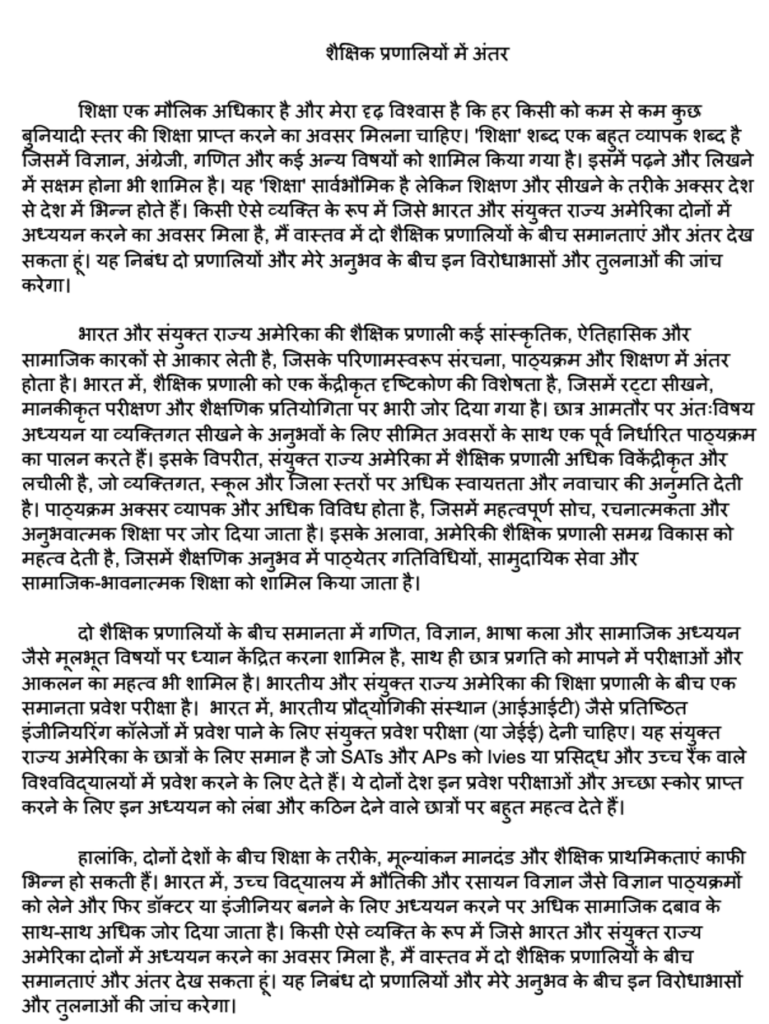Education is a fundamental right and I strongly believe that everyone should get the opportunity to get at least some basic level of education. The term ‘education’ is a very broad term covering subjects like science, english, mathematics and many others. It also includes being able to read and write. This ‘education’ is universal but the methods of teaching and learning often differ from country to country. As someone who has had the opportunity to study in both India and the United States, I can indeed see the similarities and differences between the two educational systems. This essay will examine these contrasts and comparisons between the two systems and my experience as well.
The educational systems of India and the United States are shaped by many cultural, historical, and social factors, which result in differences in structure, curriculum, and teaching. In India, the educational system is characterized by a centralized approach, with a heavy emphasis on rote learning, standardized testing, and academic competition. Students typically follow a predetermined curriculum, with limited opportunities for interdisciplinary studies or personalized learning experiences. In contrast, the educational system in the United States is more decentralized and flexible, allowing for greater autonomy and innovation at the individual, school, and district levels. The curriculum is often broader and more diverse, with an emphasis on critical thinking, creativity, and experiential learning. Furthermore, the American educational system values holistic development, incorporating extracurricular activities, community service, and social-emotional learning into the academic experience.
Similarities between the two educational systems include a focus on foundational subjects such as mathematics, science, language arts, and social studies, as well as the importance of examinations and assessments in measuring student progress. A similarity between Indian and the United States education system is the entrance exams. In India, one must give the Joint Entrance Examination (or JEE) to get into prestigious engineering colleges like the Indian Institute of Technology (IIT). This is similar for the students in the United States who give the SATs and APs to get into Ivies or well-known and highly ranked universities. Both of these countries emphasize a lot of importance on these entrance tests and the students who give these studies long and hard to get a good score.
However, the methods of instruction, assessment criteria, and educational priorities may vary significantly between the two countries. In India, there is a greater social pressure as well as higher emphasis on taking up science courses like physics and chemistry in high school and then either studying to become a doctor or an engineer. I have been in the United States for almost a year now, and based on my interactions with my roommates who are both domestic students, I have realized that high school students here do not face that kind of social pressure. They are free to study what they like without any difficulties.
My experience transitioning from the educational system in India to that of the United States was both challenging and enlightening, offering valuable insights into the strengths and weaknesses of each approach. One of the most significant lessons I learned was the importance of being able to and being open to adapting to new and unfamiliar environments. As I adjusted to the different teaching methods, assessment practices, and classroom dynamics, I discovered the value of embracing new perspectives and approaches to learning.
In the United States, the overall grade of your class is distributed into participation, homework assignments, discussions, exams and presentations. This was very new to me as I was used to not being graded for everything including class participation. In India we just have one final exam which decides our final grade and some midterm exams which carry some weight but not a lot. Initially it was difficult for me to adjust to this system of grading as I had to keep in mind a lot of things as well as submit all my assignments with my best work and not sloppy work which I could do and get away with in India. As I got accustomed to this new system of grading, I realized that it was actually helpful, attention paid in class increases, class discussions help to know your classmates and submitting multiple assignments made it much easier to remember what was taught. I still get frustrated sometimes when I have a lot of assignments and just wish I was in India where I would not have to do this but once I start my assignments, I am able to understand and remember the material better.
My exposure to the American educational system broadened my understanding of educational equity and inclusivity. I witnessed efforts to create a more inclusive and supportive learning environment for students from diverse backgrounds, including those with disabilities and smaller communities. The professors are always happy to help the students in whatever manner they can and what I like most is the concept of office hours where I can just drop by my professor’s office and ask them how many questions I want. This commitment to diversity and inclusion challenged my assumptions about education and reinforced the importance of advocating for equitable access to quality education for all learners.
The comparison of the educational systems in India and the United States offers valuable insights into the diverse approaches to teaching and learning around the world. While each system has its strengths and weaknesses, the experience of navigating a new educational environment has taught me the importance of adaptability and educational equity. As I continue my educational journey, I carry with me the lessons learned from my experiences in both India and the United States, striving to foster a culture of curiosity, creativity, and inclusivity in my own learning community.
[Hindi]


